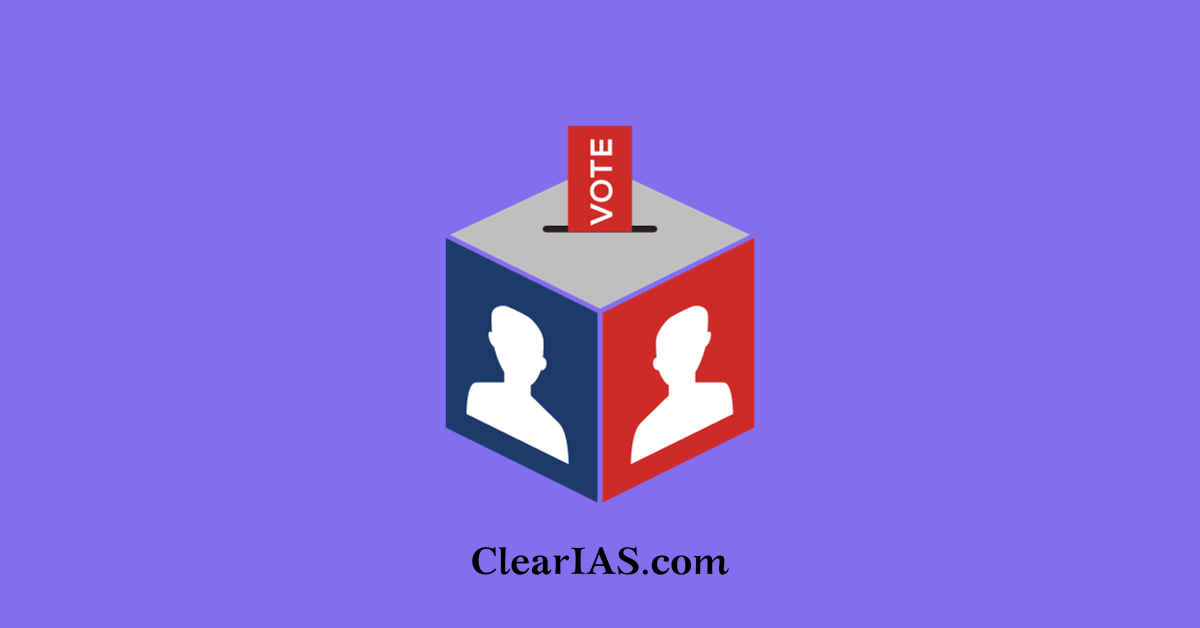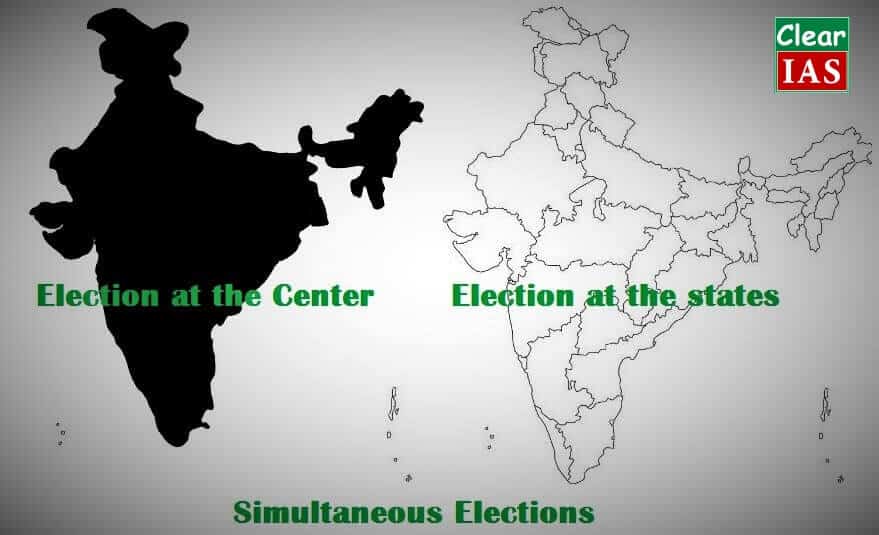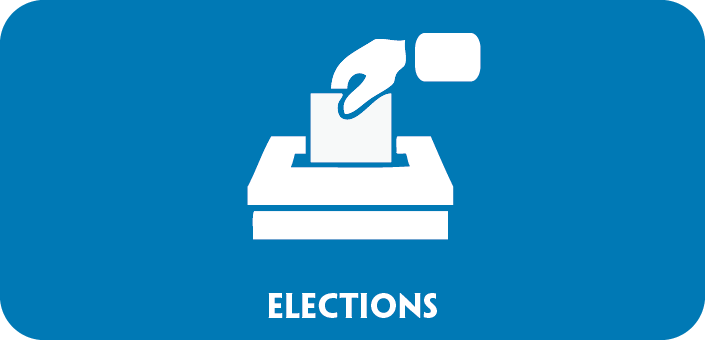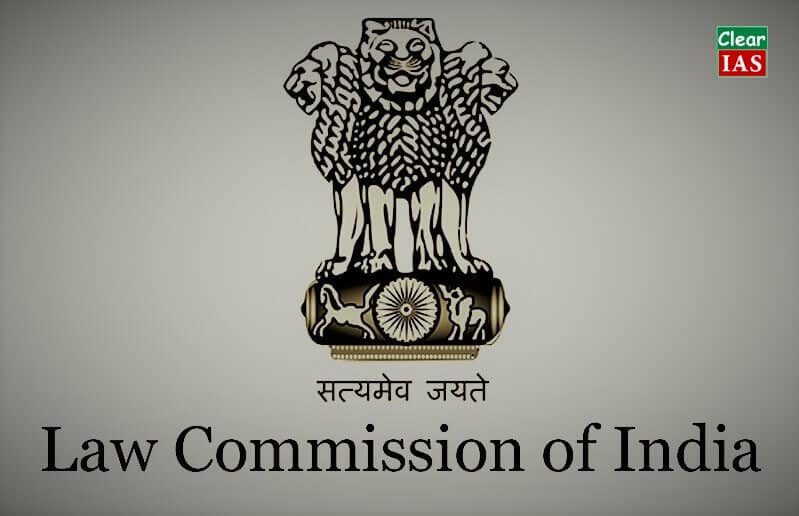 The idea of holding elections simultaneously to Lok Sabha and State Legislative Assemblies is recently in the news after it got a push from Prime Minister Narendra Modi. In this article let us discuss the concept of simultaneous elections, its advantages, disadvantages, feasibility, and other related issues.
The idea of holding elections simultaneously to Lok Sabha and State Legislative Assemblies is recently in the news after it got a push from Prime Minister Narendra Modi. In this article let us discuss the concept of simultaneous elections, its advantages, disadvantages, feasibility, and other related issues.
India has witnessed simultaneous elections during the initial years after its independence in 1951-52, 1957, 1962, and 1967.
However, due to the dissolution of some State Assemblies in 1968 and 1969 and the Lok Sabha in 1970, the cycle of simultaneous elections was disrupted.
The idea of one nation one election aims to rationalize the election process by reducing the frequency of elections, aiming to diminish the extensive administrative and financial burden associated with conducting separate elections.
What is meant by simultaneous elections?

- It refers to holding elections to Lok Sabha and State Legislative Assemblies simultaneously, once every five years.
- At present, elections to Lok Sabha and all State Legislative Assemblies are not being held simultaneously.
- Sometimes, elections to some State Legislative Assemblies may happen together with the elections to Lok Sabha. For example, in 2014, elections to State assemblies of Andhra Pradesh, Odisha, and Sikkim were held along with elections to Lok Sabha.
The idea of simultaneous elections
- The idea of simultaneous elections is not new to India. In 1951-52, the first general election to the Lok Sabha was held simultaneously with all State Assemblies. This practice of simultaneous elections continued till the general election of 1967.
- This practice was disrupted due to the premature dissolution of some State Legislative Assemblies in 1968. Lok Sabha itself dissolved prematurely in 1970.
- As a result, the elections to the Lok Sabha and State Legislative Assemblies are being held separately.
- The idea of simultaneous elections was floated long back by former deputy Prime Minister of India, LK Advani.
- In recent times, the idea got support from the President and Prime Minister. President Pranab Mukherjee has endorsed the idea by mentioning it in his address to the joint session of the parliament ahead of the budget session.
- Reports of the Law Commission and the Parliamentary Standing Committee have also favored simultaneous elections.
Advantages of simultaneous elections
- The cost of an election has two components – one, expenditure incurred by the Election Commission, and two, expenditure incurred by the political parties. A large number of government employees and public buildings are diverted from their regular responsibilities for election duties. Supporters of the simultaneous elections argue that it will reduce election expenditure in terms of finance and reduce the diversion of human resources for election duties.
- Model Code of Conduct (MCC) comes into operation during election season. MCC is seen as an obstacle to the government service delivery mechanism. Simultaneous elections may reduce such disruption.
- During elections, political convenience takes precedence over public interest. To lure voters, political parties concede to popular demands without any consideration of public interest. Simultaneous elections reduce such opportunities for political parties.
- Simultaneous election promotes the national perspective over the regional perspective. This is important for the unity of the country.
- Since it promotes a national perspective, simultaneous elections strengthen national parties. This reduces the mushrooming growth of political parties based on narrow vote bank politics.
- Simultaneous elections bring States on par with the Center. If the elections are to be held simultaneously once in five years, the elected state governments cannot be dismissed easily. This reduces the anomalies created by Article 356 (President’s Rule) of the Indian constitution and hence, it strengthens federalism.
- The simultaneous election once in five years provides stability to the governments. It allows the government to make difficult and harsh decisions in the larger public interest.
Arguments against simultaneous elections
- Simultaneous elections may reduce the expenditure incurred by the Election Commission. However, there is no guarantee that the expenditure of the political parties will be reduced. Political parties may spend the entire fund at once rather than in phases.
- Center and States are equal and sovereign within their jurisdiction. Simultaneous elections may reduce the importance of state elections. Thus it affects the concept of federalism.
- Article 83(2) and Article 172 of the Constitution require that the Lok Sabha and State legislatures be in existence for five years from the date of its first meeting, “unless dissolved earlier”. Simultaneous elections ignore this phrase, as there would be no opportunity to dissolve Lok Sabha or State Assemblies.
- A government can be in power as long as it enjoys the confidence of Parliament. Simultaneous elections can work only if governments last for a fixed tenure of five years regardless of the confidence of Parliament. It negates the concept of a ‘no-confidence motion’ – an important tool for legislative control over the executive.
- Elections are an important part of representative democracy. Simultaneous elections with a fixed tenure of five years curtail people’s right to express their confidence or displeasure with the government.
- Simultaneous elections will relegate local issues or issues of state importance to the background. This completely ignores the diversity of the country.
- Holding simultaneous elections once in five years may also face logistical challenges. For the free and fair conduct of the elections, security forces need to be deployed in large numbers. Given the current strength of security personnel, this may be a challenging task.
Some constitutional questions
 Holding simultaneous elections also poses some constitutional questions, which need to be answered. They are,
Holding simultaneous elections also poses some constitutional questions, which need to be answered. They are,
- To implement the idea, the tenure of some of the State Assemblies needs to be curtailed. How to do it, when the government enjoys the confidence of the legislature?
- How to preserve simultaneity in the event of a vote of no confidence or President’s rule?
- Article 83(2) and Article 172 of the Constitution requires that the Lok Sabha and State legislatures be in existence for five years from the date of its first meeting, “unless dissolved earlier”. This makes it clear that the constitution does not guarantee fixed terms to the Lok Sabha and State Assemblies. Simultaneous elections are not possible without fixed tenure.
Shekhawat solution
- The former vice-president Bhairon Singh Shekhawat proposed a solution. He called for a review of provisions of the no-confidence motion.
- He suggested that a no-confidence motion must mandatorily be accompanied by an alternative government formation plan. This prevents premature dissolution of Lok Sabha on account of political instability.
- But critics point out that, this solution will take away people’s right to elect or dismiss a government.
Various reports

- 79th report of the Parliamentary Standing Committee on Law and Justice recommended a two-phase election schedule – one concurrent with Lok Sabha elections, the second in the mid-term of the Lok Sabha.
- The report also recommended that to hold early elections to Lok Sabha and state legislative assemblies, one of two conditions must be met: (i) a motion for an early general election must be agreed to by at least two-thirds of all members of the House, or (ii) a no-confidence motion must be passed by the House, and with no alternative government being confirmed within 14 days of passing a confidence motion.
- The report concluded that such a reform was “important for India if it is to compete with other nations in developmental agenda on a real-time basis as a robust, democratic country.”
- Law Commission of India in its 170th report (1999) recommended simultaneous elections to Lok Sabha and State Legislative. It suggested that elections to the legislative assemblies, whose term ends six months after the general elections to Lok Sabha, can be clubbed together. However, the results of such elections can be declared at the end of the assembly’s tenure.
- The Election Commission also extended its in-principle support for the simultaneous elections.
One Nation One Election
The High-Level Committee (HLC) on ‘’One Nation, One Election,” headed by former President Ram Nath Kovind, submitted its report on the feasibility of conducting simultaneous polls to President Droupadi Murmu on March 14, 2024.
- The 18,626-page report contains 11 chapters along with annexures and has been prepared after extensive consultations with stakeholders and experts over 191 days.
- The panel unanimously recommended simultaneous elections for Lok Sabha and State Assemblies as the first step followed by synchronized local body polls within 100 days, highlighting that such a mechanism will augment development and social cohesion and deepen the “foundations of the democratic rubric.”
Impact on voter behavior
- Studies show that simultaneous elections will have a significant impact on voter’s behavior. An analysis by IDFC institute shows that on average, there is a 77 percent chance that the Indian voter will vote for the same party for both the State and Centre when elections are held simultaneously.
- In such cases, the national issues and national parties take precedence over issues of state importance and small regional parties.
A case for frequent elections
- Frequent elections enhance political accountability. It keeps politicians on their toes.
- Local issues, state issues, and national issues do not get mixed up. A staggered election cycle gives people an opportunity to distinguish between these issues.
- Elections create a large number of work opportunities for the people.
In news
2024: The Union Cabinet chaired by the Prime Minister has accepted the recommendations made by the High-Level Committee on holding simultaneous elections to the Lok Sabha, State Legislative Assemblies and local bodies (Panchayats and Municipalities).
- In March, the High-Level Committee under the Chairmanship of former President Ram Nath Kovind submitted its report on “One Nation, One Election”.
Conclusion
As discussed above the idea of simultaneous elections has Advantages as well as difficulties in implementation. Solutions should be found to specific problems.
- The model code of Conduct shouldn’t be stretched too long. There should be clear guidelines on do’s and don’ts for the government.
- To curb election expenditure, alternative ways such as reforms in the expenditure of political parties and state funding of political parties could be discussed.
There are various ifs and buts before the idea of simultaneous elections can finally be implemented. The Constitution may need to be amended. But care should be taken, such that simultaneous elections will not undermine the federalism and diversity of the country.
Read:
Article by: Divakar Shenoy H






Wonderful info
Very interesting points covered from both positive and negative aspects.
Sir your articles are amazing can I get that in hindi
Where is webinar?????
I dont get any notification. Its 11:07. What is this.
Very detailed..!! Covered all aspects of the topic. As usual as all articles, it’s nice and informative..!!
Goods points are mentioned… I think this is very helpful to students… Who are preparing for ias exam…
In shekawat solution, if a plan is formulated for interim government till election Then it will be a wise solution. whats your view?
sir plz provide me in hindi all sets thanks u
commendable work
Sir/Madam
Can you please provide information regarding the provisions for by-election of parliament or state legislature in India.
A very good Insight provided, covering every aspect of the topic.
It’s really informative …points covered are very clear.
Simultaneous Elections will solve no problem. The root problem of EC is that it is in a seasonal business. Busy for 2 months in 5 years followed by a lean period of 4 years and 10 months.
This can be changed by dividing 550 parliamentary constituencies into 60 sectior and holding elections in sector once every 5 years.
The cost will go down by 95% and other problems of constructional amendments and migration will remain.